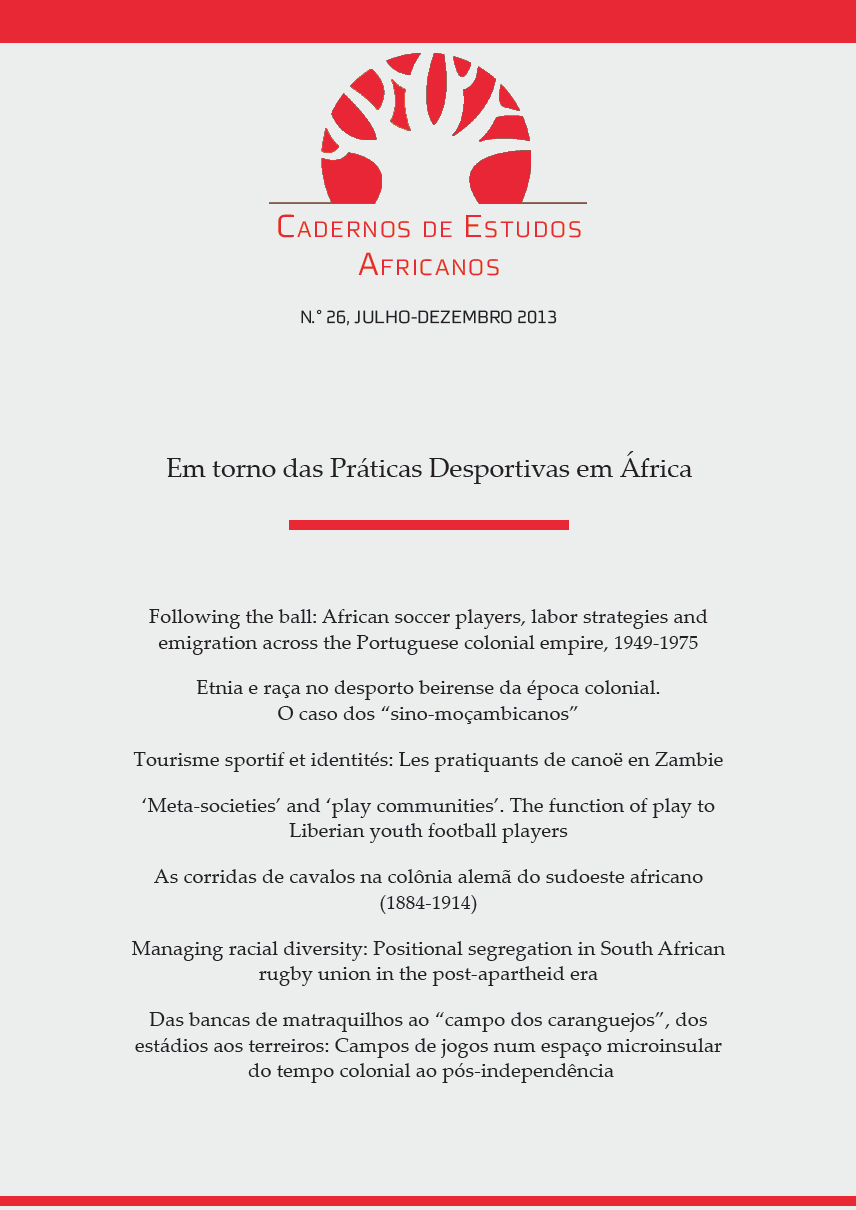‘Meta-societies’ and ‘play communities’. The function of play to Liberian youth football players
DOI:
https://doi.org/10.4000/cea.1135Palavras-chave:
youth, community, football, play, culture, statusResumo
This inquiry considers three distinct areas, firstly the Liberian definition of ‘youth’ and their post-conflict identity, secondly the tradition of community and the post conflict living arrangements, and thirdly the theme of this investigation, the use and participation of football and play amongst the ‘youth’ male population; its structure, rules, function, role, frequency, meaning and relationship to the wider society and status.Referências
Argenti, N. (2007). The intestines of the State: Youth, violence, and belated histories in the Cameroon grassfields. Chicago & London: The University of Chicago Press.
Caillois, R. (1961). Man, play and games. Urbana & Chicago: University of Illinois Press.
Cote, J. E. (2000). Arrested adulthood: The changing nature of maturity and identity. New York & London: New York University Press.
O’Brien, D. C. (1996). A lost generation? Youth identity and State decay in West Africa. In Werbner, R., & Ranger, T. (Eds.), Postcolonial identities in Africa (pp. 55-74). London & New Jersey: Zed Books.
Dalton, G. (1965). History, politics, and economic development in Liberia. The Journal of Economic History, 25 (4), 569-591.
European Youth Forum. (n.d). Report on youth NGOs: Reaching out to more young people and in particular, disadvantaged young people. In http://www.youthknot.net/uploads/documents/reaching-youth.pdf (accessed May 15, 2012).
Henricks, T. S. (2006). Erving Goffman on play as encounter. In Henricks, T. S., Play reconsidered: Sociological perspectives on human expression (pp. 146-180). Urbana: University of Illinois Press.
Huizinga, J. (1950). Homo ludens. A study of the play-element in culture. Boston: The Beacon Press.
Moran, M. H. (2006). Liberia: The violence of democracy. Philadelphia: University of Pennsylvania Press.
Olofson, H. (1977). Playing a kingdom: A Hausa meta-society in the walled city of Zara, Nigeria. In Lancy, D. F., & Tindall, B. A. (Eds.), The anthropological study of play: Problems and prospects (pp. 167-175). West Point, N. Y.: Leisure Press.
USAID. (2009). Liberia youth fragility assessment. In http://pdf.usaid.gov/pdf_docs/PN ADQ258.pdf (accessed May 10, 2012).
Utas, M. (2005). Building a future? The reintegration and re-marginalisation of youth in Liberia. In Richards, P. (Ed.), No peace, no war: An anthropology of contemporary armed conflicts (pp. 137-154). Oxford & Athens: James Currey & Ohio University Press.
Vigh, H. (2006). Social death and violent life chances. In Christiansen, C., Utas, M., & Vigh, H. E. (Eds.), Navigating youth, generating adulthood: Social becoming in an African context (pp. 31-60). Uppsala: Nordiska Africainstitutet.
Downloads
Publicado
Edição
Secção
Licença
Direitos de Autor (c) 2016 Cadernos de Estudos Africanos

Este trabalho encontra-se publicado com a Licença Internacional Creative Commons Atribuição-NãoComercial-CompartilhaIgual 4.0.
Autorizo a publicação do artigo/recensão submetido do qual sou autor.
Declaro ainda que o presente artigo é original, que não foi objecto de qualquer tipo de publicação, e cedo em exclusivo os direitos de publicação à revista Cadernos de Estudos Africanos. A reprodução do artigo, no todo ou em parte, noutras publicações ou noutros suportes depende de autorização prévia da editora Centro de Estudos Internacionais do Iscte - Instituto Universitário de Lisboa.

